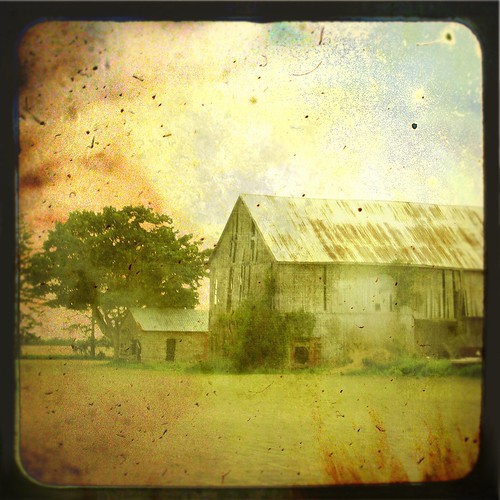
Alice Heun: The Corn Crib, 1934 photo by Smithsonian American Art Museum/flickr
note: I don’t have any money, but listening to this guy makes me want to find some. Check this out, great way to raise money BTW:
This is a story from the Great Depression as told by Letty Owings, age 87. It is a true account of three organized community activities in a small rural farming community in Missouri during the 1930s.
The Blue Taffeta Dress
While we worked hard on the farm during the drought years in the mid-1930s, we also set aside three days each year for entertainment. These days were community organized and structured fun that everyone looked forward to and talked about all year.
Each autumn we had a pie supper at the rural school that served as our community center. The idea was that a woman, or usually a girl baked a pie, and the pies were auctioned off. The auctioneer, who was sometimes my father, would hold up the pie and chant, “Now what am I to give for this pie, ten cents who’ll give me ten cents, ten, and raise it to fifteen, ah fifteen and twenty, twenty cents over here and thirty thirty do I hear forty…” A girl would want a good price for her pie, and she may say, “My, they paid a dollar for my pie!” Many of the pies were milk-based custards because mince was too expensive. Pumpkin, squash and apple pies were popular, and on occasion when someone could afford raisins, there was raisin pie.
The rule was that the man who bought the pie shared the pie with the girl who baked it. The quality of the pie didn’t have much to do with the price of eggs, it was the gathering and the fun that mattered. The people would gossip about the drought and gossip about their kids, and interject with who bought what pie for how much by saying things like, “Yeah, you know, he bought her pie.” Nobody ever kept any of the money for the pies. The funds went into the school.
On the last day of school, every woman in the community brought something to eat to the annual basket dinner at school. Women took a great deal of pride in what they brought, whether it was pickles, beans, apple butter or other dishes, so the basket dinner was both contest and entertainment. The women put the food out on the ground for all to enjoy, and we ate on the ground. Some of the coal miner kids were too poor to bring food, but the country people were very generous, so the kids all got to eat.
There was no separation of church and state back in those days, so the next big event, the Christmas program, was held either at the school or at the church, and everyone started planning for it in October. We had an old piano with missing keys and back then no one looked askance that we sang religious songs and Christmas carols. The kids gave speeches and participated in plays that were read from a Depression-era book with scripts. The dialogue was humorous or it delivered some sort of a lesson, but it was all copied, sometimes from Charles Dickens and often from other sources. The names of some of the plays were: Mr. Dash Goes Shopping, Tramp at the Picnic, Change of Heart, and Too Much Spending, but there were others.
I often had a part in the Christmas play, but I never had any decent clothes until 1932 when my Grandpa went blind. My dad took him to California on a train because it was better for my grandfather to be with kinfolks in California who had a little more money. My dad returned with two avocados. We had never seen an avocado and did not quite know what to do with them, so my mother cut them into pieces and put them in the flour bin. We would get a piece, shake the flour off and cut it into bites. My cousin in California with money gave my dad a blue taffeta dress for me, and this put me in a world of my own. It had a lace collar and lace cuffs and nobody that I knew ever had a blue taffeta dress with a lace collar and lace cuffs. My cousin did stage dancing, so she had plenty of access to nice clothes.
I decided to wear the dress for my part in the Christmas play.
The play said that I had to have chewing gum, so I got a stick of chewing gum, but I did not know what to do with chewing gum, so I rolled it on my fingers. The gum got stuck on the blue taffeta dress. I was frantic and nearly forgot my lines, the dress was not washable and I did not want my mother to know, but I had to tell her. My mother figured out that if we put ice on the dress it would freeze the gum so that I could pull it off. So, I am in the back yard with the blue dress in the snow because we did not have any ice to put on the dress.
I wore that blue taffeta dress until I could no longer squeeze myself into it, and years later, I visited my cousin in a nursing home, and told her how much that blue dress meant to me.
note: The scripts in the playbook from that time are fascinating, and will be the subject of a future essay, as they reflect the culture of the time.









